Coins of Tsarist Russia. Silver coins
How much are the most expensive coins of tsarist Russia and where can I buy them? Surely you have repeatedly asked yourself these questions. The coins presented in this post are unlikely to come across to any of you, but the history of each coin is very interesting.
At the same time, the concept of “most expensive coin” is very arbitrary. There is always the possibility that there is an even rarer and more expensive specimen that will break the existing price record.
10 most expensive coins of tsarist Russia
20 rubles in 1755
This is the most expensive coin of Tsarist Russia. It is known that one copy of this coin was sold at auction of 1,782,500 pounds. This is a very rare coin; today only two of its copies are known. One is in the Hermitage, and the second in a private collection.
This coin was minted in gold during the reign of Empress Elizabeth Petrovna in 1755 at the mint of St. Petersburg. The obverse of this coin depicts the Empress Elizabeth Petrovna herself. On the back is a cross consisting of five cartouches. In the center is the coat of arms of the Russian Empire, and around the arms of Kazan, Moscow, Siberia and Astrakhan.
1 ruble of 1730, or as it is also called "Anna with the chain"
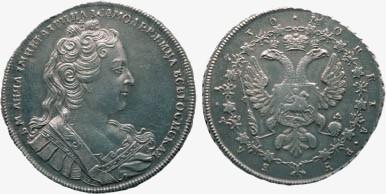
The cost of the coin varies in the region of $ 700,000, it was for this amount that one of the copies of the coin 1 ruble of 1730 was sold.
The coin was minted in the first years of the reign of Empress Anna Ioannovna in 1730 from silver. And received in common people the name "Anna with a chain." A very rare coin, since only three copies of “Anne with a Chain” are known.
The obverse of the coin depicts a portrait of the empress herself. And the reverse of “Anna with a chain” is decorated with the emblem of Imperial Russia - a two-headed eagle with three crowns, which is surrounded by a chain of the Order of St. Andrew the First-Called.
12 rubles 1836
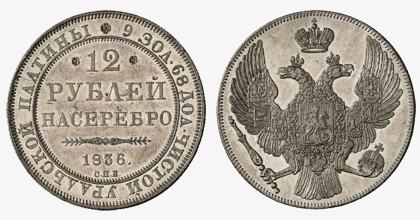
In 2011, at one of the auctions, the original coin of 12 rubles in 1836 was sold for 4,650,000 rubles.
It is known that coins in nominal value of 12 rubles in 1836 were minted in very small quantities, namely in a print run of 11 pieces. And this is the only platinum coin in the world that has been issued for circulation on the market. Very rare instance.
Although it is known that at the end of the 19th century, by the order of private collectors, a certain number of “rubles” was issued, but they are all considered remodels. And their price is much inferior to the originals.
5 rubles in 1907
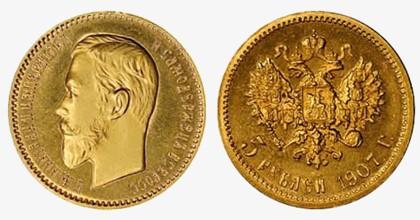
In March 2011, a coin of 5 rubles in 1907 was sold for 4,350,000 rubles.
This coin has a very interesting story. In August 1907, near St. Petersburg, the construction of the church of St. Olga in the camp of the Life Guards Horse Regiment. And for this event, the mint struck 100 gold coins in denominations of 5 rubles, which were laid in the foundation of the church. From ordinary five-ruble coins, they differed only in the date of issue. In addition to the 100 coins that were laid in the foundation of the temple, more than five rubles were not issued, so this coin was never in circulation.
After the ceremony of laying the foundation of the temple, another nine 5 ruble coins of 1907 surfaced. As it turned out, they were minted along with those, but only in order to distribute them by the participant of the event.
1 ruble of 1825 or “Konstantinovsky ruble”
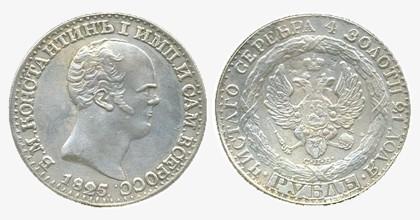
This is probably the most famous coin. And its origin is shrouded in a veil of mysteries, because the Emperor with the name Constantine in Russia has never been. Then in honor of whom it was minted? There are two versions. According to the first, this is a simple mistake of the mint workers, which of course is unlikely. But based on the second version, the “Konstantinovsky ruble” was minted with the expectation of the coronation of Tsarevich Konstantin Pavlovich. But he subsequently abdicated in favor of his brother Nicholas I. But the coin remained.
The obverse of the coin depicts a bald man with sideburns and a short upturned nose. In a circle of coins there is an inscription: ”B, M. Konstantin I IMP and ITSELF ALLOS ”and the year 1825 is indicated. The reverse shows a double-headed eagle with regalia surrounded by a wreath of leaf laurels. Under the eagle is indicated the mint that minted this coin - St. Petersburg. In a circle the inscription: “Ruble. Pure silver 4 gold 21 share. " The inscription is engraved on the edge (edge) of the coin: “ser 83 13 samples 4 ash. 82 1425 shares. "
The cost of this coin ranges around $ 100,000.
1 kopeck of 1726
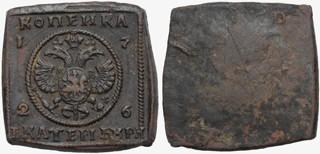
The value of the coin is extremely high, despite the fact that it is made of copper. At one of the auctions, 1 kopeck of 1726 was sold for 2,000,000 rubles.
The coin has an unusual shape and weight. The penny is made in the form of a square and has a weight of 16.38 grams. And the size is 23x23 mm. It was minted in 1726 in the mint of the city of Yekaterinburg.
Only 10 copies of the coin that have survived to this day are known for certain.
25 rubles in 1908
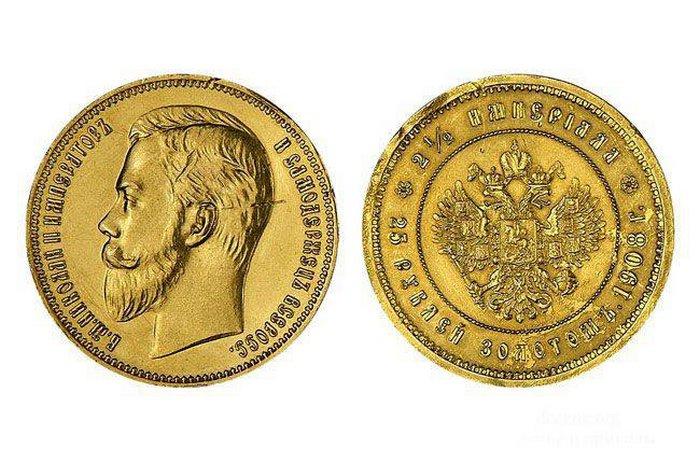
What is its cost is very difficult to say. It is only known that the “25 rubles 1908” coin of poor quality (with scratches and nicks) at one of the auctions sold 1,900,000 rubles. And according to some experts, a coin of good quality may cost twice as much.
The coin is also very rare and expensive. A more interesting story is its origin.
A large gold nugget weighing 5 kilograms was found at the imperial mines in Siberia at the beginning of the 20th century. At that time, the reigning emperor, Nicholas II, wanted to make coins from gifts of gold for gifts to his relatives and friends at the celebration of his birthday. The nugget was only enough for 150 gold coins. Later, by order of Prince George Mikhailovich, a passionate collector, another 25 coins were minted.
5 kopecks of 1916
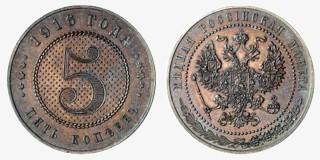
This coin is the fruit of a failed monetary revolution. As you know, in those years the First World War was fought. In this connection there was a shortage of silver and copper for minting coins. Therefore, it was decided to issue money twice as easily. But the revolution that happened prevented the realization of the plan. But the trial batch was still minted. What circulation the trial batch had was not known.
And in 1927, a certain amount of coins for collectors were minted at the Leningrad Mint with a genuine stamp. But despite this, 5 kopecks of 1916 is considered rare.
One copy of the five-copeck coin of 1916 was sold at auction for 1,600,000 rubles.
1 ruble of 1806

Emperor Nicholas I, who ascended the throne, for some reason banned the minting of coins with his profile. Although award medals with his portrait were issued.
In the mid-19th century, remodels of 1 ruble coin with its image in the amount of about 30 pieces were issued at the Mint of St. Petersburg, by private order.
The reverse of the coin depicts Nicholas I in the guards uniform, and the obverse is decorated with a two-headed eagle - the emblem of the imperial power.
One of the coins “1 ruble of 1806” was sold for 1,550,000 rubles. Although experts, numismatists claim that its current value is more than 2 million rubles.
1 ruble of 1705 or “Polish Thaler”
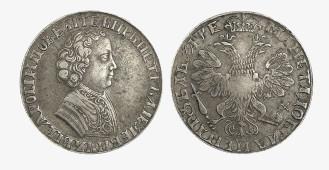
In 1704, by decree of Peter I, silver coins were introduced into circulation, reminiscent in appearance of the Polish thaler of the sample of 1630. The fact is that until 1730, when silver deposits were developed in Altai, a strong silver deficit was observed in the Russian Empire. In this connection, coins were minted from imported metal. Sometimes the “imported” coins were not even melted, but were immediately sent to the press.
Therefore, the coin 1 ruble of 1705 was minted from the Polish thaler, and even with an error in writing the date.
A coin with an error in writing the date is valued. One of the coins “1 ruble of 1705” was sold at auction for 1,500,000 rubles. A coin of the same denomination, but made of molten metal, was sold for just 400,000 rubles.
It is unlikely of course, but suddenly you have one of these coins stored, and you do not even know how much it costs
1) 20 rubles in 1755. 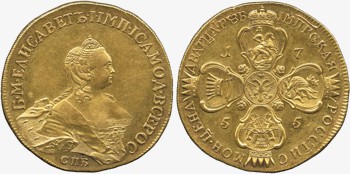
This is the most expensive coin of Tsarist Russia. It is known that one copy of this coin was sold at auction of 1,782,500 pounds.
This coin was minted in gold during the reign of Empress Elizabeth Petrovna in 1755 at the mint of St. Petersburg.
The obverse of this coin depicts the Empress Elizabeth Petrovna herself.
On the back is a cross consisting of five cartouches. In the center is the coat of arms of the Russian Empire, and around the arms of Kazan, Moscow, Siberia and Astrakhan.
This is a very rare coin; today only two of its copies are known. One is in the Hermitage, and the second in a private collection.
2) 1 ruble of 1730, or as it is also called "Anna with the chain." 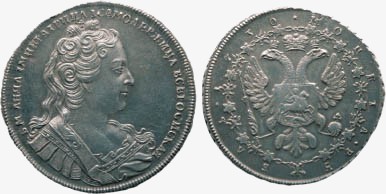
This is also a rare and expensive coin of Imperial Russia. It was minted in the first years of the reign of Empress Anna Ioannovna in 1730 from silver. And received in common people the name "Anna with a chain."
The obverse of the coin depicts a portrait of the empress herself. And the reverse of "Anne with a Chain" is decorated with the emblem of Imperial Russia - a two-headed eagle with three crowns, which is surrounded by a chain of the Order of St. Andrew the First-Called.
As I said earlier, this is a very rare coin, since only three copies of Anne with the Chain are known.
The cost of the coin varies in the region of $ 700,000, it was for this amount that one of the copies of the coin 1 ruble of 1730 was sold.
3) 12 rubles in 1836. 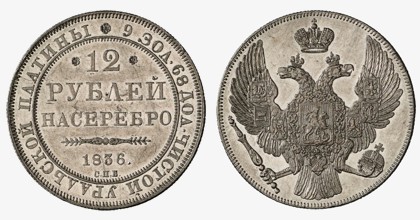
This is the only platinum coin in the world that has been released for circulation on the market.
And is a rare coin. It is known that coins in nominal value of 12 rubles in 1836 were minted in very small quantities, namely in a print run of 11 pieces. Although it is known that at the end of the 19th century, a certain number of “rubles” were issued by order of private collectors, they are already considered remodels. And their price is much inferior to the originals.
In the past, 2011, at one of the auctions, the original coin of 12 rubles in 1836 was sold for 4,650,000 rubles.
4) 5 rubles in 1907. 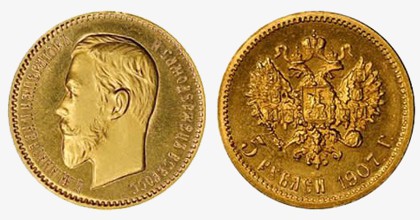
It is also a very valuable and rare coin. She has a very interesting story.
In August 1907, near St. Petersburg, the construction of the church of St. Olga in the camp of the Life Guards Horse Regiment. And for this event, the mint struck 100 gold coins in denominations of 5 rubles, which were laid in the foundation of the church.
From ordinary five-ruble coins, they differed only in the date of issue. In addition to the 100 coins that were laid in the foundation of the temple, more than five rubles were not issued, so this coin was never in circulation.
After the ceremony of laying the foundation of the temple, another 9 5 ruble coins of 1907 surfaced. As it turned out, they were minted along with those, but only in order to distribute them by the participant of the event.
It is known that in March 2011, a coin of 5 rubles in 1907 was sold for 4,350,000 rubles.
5) 1 ruble of 1825, or as it is more known, "Konstantinovsky ruble". 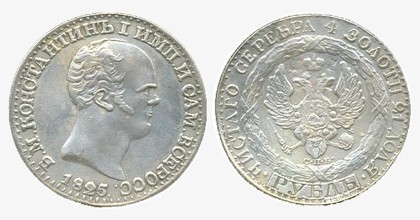
This is probably the most famous coin in Russia. And its origin is shrouded in a veil of mysteries, because the Emperor with the name Constantine in Russia has never been. Then in honor of whom it was minted?
But there are two versions. According to the first, this is a simple mistake of the mint workers, which of course is unlikely. But based on the second version, the "Konstantinovsky ruble" was minted with the expectation of the coronation of Tsarevich Konstantin Pavlovich. But he subsequently abdicated in favor of his brother Nicholas I. But the coin remained.
The obverse of the coin depicts a bald man with sideburns and a short upturned nose. In the circle of the coin there is an inscription: “B, M. Konstantin I IMP and SAMEROSS ALL” and the year 1825 is indicated.
The reverse depicts a double-headed eagle with regalia surrounded by a wreath of laurel leaves. Under the eagle is indicated the mint that minted this coin - St. Petersburg. In a circle the inscription: "Ruble. Pure silver 4 gold. 21 share."
The inscription is engraved on the edge (edge) of the coin: "ser 83 13 samples 4 gold 82 1425 shares."
The cost of this coin ranges around $ 100,000.
6) 1 kopeck of 1726. 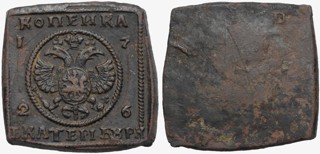
It is also a rare and expensive copper coin. It has an unusual shape and weight. The penny is made in the form of a square and has a weight of 16.38 grams. And the size is 23x23 mm. It was minted in 1726 in the mint of the city of Yekaterinburg.
Only 10 copies of the coin that have survived to this day are known for certain. Its cost is great, despite the fact that it is made of copper. At one of the auctions, 1 kopeck of 1726 was sold for 2,000,000 rubles.
7) 25 rubles in 1908. ![]()
The coin is also very rare and expensive. A more interesting story is its origin.
A large gold nugget weighing 5 kilograms was found at the imperial mines in Siberia at the beginning of the 20th century. At that time, the reigning emperor, Nicholas II, wanted to make coins from gifts of gold for gifts to his relatives and friends at the celebration of his birthday. The nugget was only enough for 150 gold coins. Later, by order of Prince George Mikhailovich, a passionate collector, another 25 coins were minted.
What its cost is not exactly known. It is only known that the “25 rubles 1908” coin of poor quality (with scratches and nicks) at one of the auctions sold 1,900,000 rubles. And according to some experts, a coin of good quality may cost twice as much.
8) 5 kopecks in 1916. 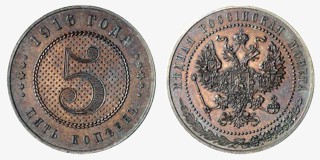
This coin is the fruit of a failed monetary revolution. As you know, in those years the First World War was fought. In this connection there was a shortage of silver and copper for minting coins. Therefore, it was decided to issue money twice as easily. But the revolution that happened prevented the realization of the plan. But the trial batch was still minted. What circulation the trial batch had was not known.
And in 1927, a certain amount of coins for collectors were minted at the Leningrad Mint with a genuine stamp. But despite this, 5 kopecks of 1916 is considered rare. One copy of the five-copeck coin was sold at auction for 1,600,000 rubles.
9) 1 ruble of 1806. 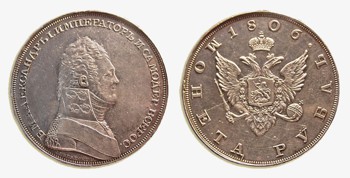
Emperor Nicholas I, who ascended the throne, for some reason forbade the minting of coins with his profile. Although award medals with his portrait were issued.
In the mid-19th century, remodels of 1 ruble coin with its image in the amount of about 30 pieces were issued at the Mint of St. Petersburg, by private order.
The reverse of the coin depicts Nicholas I in the guards uniform, and the obverse is decorated with a two-headed eagle - the emblem of the imperial power.
One of the coins “1 ruble of 1806” was sold for 1,550,000 rubles. Although experts, numismatists claim that its current value is more than 2 million rubles.
10) 1 ruble of 1705 or the "Polish Thaler". 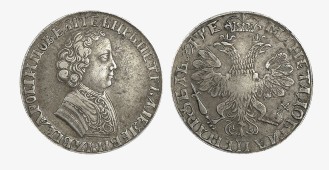
In 1704, by decree of Peter I, silver coins were introduced into circulation, reminiscent in appearance of the Polish thaler of the sample of 1630. The fact is that until 1730, when silver deposits were developed in Altai, a strong silver deficit was observed in the Russian Empire. In this connection, coins were minted from imported metal. Sometimes the “imported” coins were not even melted, but were immediately sent to the press.
Therefore, the coin 1 ruble of 1705 was minted from the Polish thaler, and even with an error in writing the date.
A coin with an error in writing the date is valued. One of the coins “1 ruble of 1705” was sold at auction for 1,500,000 rubles. A coin of the same denomination, but made of molten metal, was sold for just 400,000 rubles.
How much are the most expensive coins of tsarist Russia? Where can I find them? Surely you have repeatedly asked yourself such questions. And this is not surprising. The answers to them have always been of interest, and will be of interest to a large number of people, and not only collectors and numismatists. Unfortunately, and perhaps fortunately, there is no single answer to these questions, since the very concept of “most expensive coin” is very arbitrary. There is always the possibility that there is an even rarer and more expensive specimen that will break the existing price record.
The centuries-old history of the Russian Empire is perfectly reflected in the coins of that time, among which there are special, even if you want exclusive items, the value of which is now just off scale, and the historical and cultural significance cannot be overestimated! Using these coins, one can easily study the great history of our vast country, because they depicted portraits of the most significant people for the state, and symbols of the Russian state, and the most important attributes of the era, and even many, sometimes contradictory, historical facts and events. This is probably why many, even the smallest coins of the time, are very much appreciated today.
I am sure that every numismatist would like to have at least one such rarity in his collection, but, unfortunately, not many, but only a few manage to take possession of this genuine treasure. Those who are in the circle of the elect and have in their collection one of the coins described below can rightfully be proud of their collection and call it priceless. I suggest that you familiarize yourself with a brief description of the most expensive coins of Tsarist Russia in chronological order.
1 ruble of 1705 (“Polish Thaler”) - 1.5 million rubles.
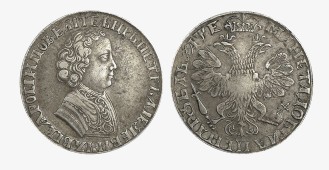
1 ruble of 1705
In 1704, Peter I, by decree, introduced silver coins, reminiscent of their appearance, the Polish thaler model of 1630. The fact is that until 1730 in Russia there was an acute shortage of silver, which was used to mint coins and had to be imported from abroad. A coin in denomination of 1 ruble in 1705 was minted from the Polish thaler of the issue of 1630, and with an error in writing the date. Today, at the Coins and Medals auction, 1 ruble of 1705 was sold for 1.5 million rubles. For comparison: the ruble of the same year was sold without error “only” for 400 thousand rubles.
1 kopeck of 1726 (square) - 2 million rubles.
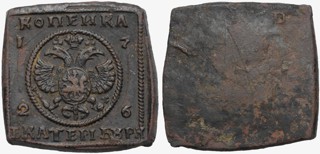
1 kopeck of 1726
A very rare and expensive copper penny, which has an unusual shape and weight. Only 10 copies have survived to this day. This is the largest Russian penny, has a square shape, its size is 23x23 mm, and weight 16.38 g. It was produced in 1726 at the mint in the city of Yekaterinburg. Recently, at a Moscow auction, it was sold for 2 million rubles.
This is not the only square coin of Tsarist Russia. In those years (1725-1727), square coins and other denominations were issued, in particular the largest square copper ruble, whose weight is 1,638 kg!
1 ruble of 1730 (“Anna with a chain”) - 700 thousand US dollars
![]()
1 ruble of 1730
In the first year of the reign of Empress Anna Ioannovna (niece of Peter I), new silver coins were issued in the Russian Empire. The rarest and most expensive of them are coins in denominations of 1 ruble of 1730, which were popularly called "Anna with a chain." On the front side of the coin (obverse) is a portrait of Empress Anna Ioannovna, who ascended the throne that year, and on the reverse side of the coin (imperial reverse) is the imperial coat of arms of Russia - a two-headed eagle with three imperial crowns, surrounded by a chain of the Order of St. Andrew the First-Called. To date, only three copies of these rare coins are known, one of which was sold in 2007 at the Coins and Medals auction for a record amount of 700 thousand US dollars. This is the most expensive coin of Tsarist Russia at that time.
20 rubles in 1755 - 1 million 550 thousand pounds.
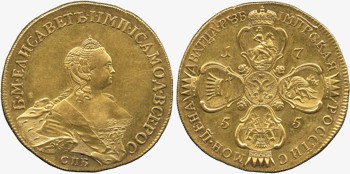
20 rubles in 1755
After the monetary reform of 1755, a gold coin with a new face value of 20 rubles, which had never been used in Russia before, was issued into the sphere of circulation. During the reform, only two copies of these coins were issued. Today, one copy is stored in the Hermitage, and the second belongs to a private collector who bought this coin for 1 million 550 thousand pounds (with a commission of 1.7825 million pounds) at a St. James auction in London in 2008. 20 rubles in 1755 is the most expensive coin of tsarist Russia, setting a new world record for value paid for a non-American coin and not beaten until now.
1 ruble of 1806 - 1.55 million rubles.
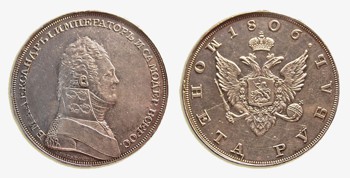
1 ruble of 1806
Emperor Alexander I for an unknown reason forbade minting coins with his profile, although award medals depicting his portrait were issued. In the 19th century, by order of private individuals, the St. Petersburg Mint issued new remodels of these coins in the amount of about 30 copies, one of which today was sold at the Coins and Medals auction for 1.55 million rubles. A little later, in 2007, the price rose to 2 million rubles.
1 ruble of 1825 ("Konstantinovsky ruble") - 100 thousand US dollars.
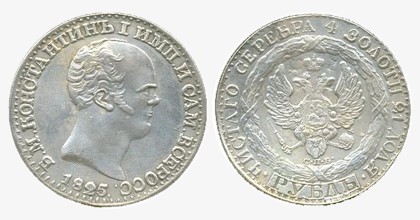
1 ruble of 1825
Perhaps the most widely known coin of the Russian Empire is the Konstantinovsky ruble, whose auction price exceeds 100,000 US dollars. The story of this coin is shrouded in a veil of secrecy. The fact is that in Russia there never was an emperor named Konstantin. Some researchers believe that most likely a common mistake was made at the mint. However, there is another, more likely version, according to which the coin was made with the expectation of the coronation of Tsarevich Konstantin Pavlovich, who actually renounced the reign in advance in favor of his brother Nicholas I.
The history of the appearance of the Konstantinovsky ruble
After his death in November 1825, without the children of Emperor Alexander I, his brother, Konstantin Pavlovich, was to enter the throne. However, this did not happen, since in 1819 Constantine renounced his rights to the royal throne. True, only his mother, Empress Maria Fyodorovna, brother Nikolai Pavlovich, and several closest friends of the royal family knew about this. In 1823, the manifesto of Alexander I was prepared, in which the third brother, Nikolai Pavlovich, was recognized as the heir to the throne. The document was kept secret and kept in a sealed bag, which was only required to be opened after the death of Alexander I. It became known that St. Petersburg died on November 27, 1825, and a few hours later the bag was printed and read in the State Council. However, even before the opening of the manifesto, Nicholas and the guard managed to swear Konstantin. Constantine, who had been in Warsaw since 1815, sent his confirmation of the fact of abdication of the royal throne to Petersburg with his younger brother Mikhail Pavlovich, and he refused to go to the capital for a public statement.
For two weeks, a period of uncertainty continued in the country, as the oath given by the guard and Nikolai Konstantin de jure made him emperor. In such a difficult situation, the St. Petersburg Mint urgently began work on the production of a test sample of a new coin of 1 ruble denomination with a portrait of Konstantin. Sketches of the front and back sides of the new coin were drawn, on which three pairs of stamps were made.
While preparations were underway at the mint for the release of new coins, the interregnum was over. December 13, 1825 Nicholas I announced in the State Council a manifesto on his accession to the throne. This news quickly flew around the capital. On December 14, a new oath of troops was appointed. Under the pretext of protecting the rights of Constantine, whose brother allegedly usurped the throne, the soldiers, under the leadership of members of the secret society of the Decembrists, had to refuse to swear allegiance to Nikolai and raise an uprising. Planned abolition of serfdom, the elimination of autocracy and the assassination of the king. However, the Decembrist uprising was crushed, its leaders executed, and the participants sent to exile and hard labor.
Finance Minister E. F. Kankrin, the news of a new oath prompted to urgently destroy the traces of the release of test coins with a portrait of Konstantin, because in this situation, this inappropriate initiative of his could turn out for him disastrously. Initially, there were six full-fledged copies of these coins, but later the sixth instance disappeared somewhere. Five completely prepared trial coins were classified and stored for 50 years in the archives of the Ministry of Finance in St. Petersburg until the accession to the throne of Alexander II.
In 1878, five rare trial Konstantinovsky rubles stored in a "secret" package, by order of Emperor Alexander II, were distributed between the emperor’s closest relatives and himself. Three copies went to: the son of Grand Duke Sergei Alexandrovich, the nephew of Grand Duke George Mikhailovich and the brother-in-law of Prince Alexander of Hesse. Another copy remained with the emperor, and the fifth was transferred to the Münz-cabinet of the Imperial Hermitage.
To date, according to official figures, there are six instances of these rare coins (according to other sources, five). Two copies are stored in Russian museums, one in the Smithsonian Institution of the United States, and three more are in private collections abroad. There are several high-quality fakes.
12 rubles in 1836 - 4.65 million rubles.
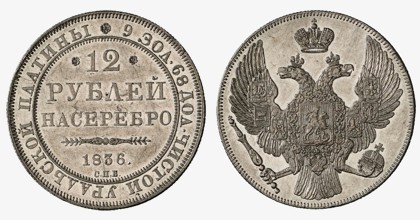
12 rubles 1836
The Russian Empire is the only country in the world where minted platinum coins for the sphere of circulation. Coins in denominations of 12 rubles in 1836 came out in a very limited edition, only 11 copies. The remaining famous specimens were minted in the 2nd half of the 19th century by order of private collectors and are remodels. To date, the cost of originals is constantly growing. So, in December 2010, one of the original copies of this rare coin was sold at the auction of the British auction house Bonhams for $ 96,000 (about 3 million rubles), and in April 2011 at the auction “Coins and Medals” for 4.65 million . rubles.
1 ruble of 1861 - 1.4 million rubles.
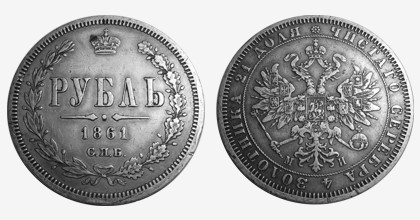
1 ruble of 1861
Numismatists always especially appreciate the perfect condition of the coins and are willing to pay well for it. Despite the fact that the circulation of 1 ruble denomination in 1861 was quite large, more than 70 thousand copies, one of them in perfect condition was sold in April 2011 at the auction of the Russian Numismatic House for 1.4 million rubles . Until this moment, the coin was put up for auction at the reputable German auction Gorny & Mosch in 2005. Then someone bought it for only € 5250 (about 180 thousand rubles).
5 rubles in 1907 - 4.35 million rubles.
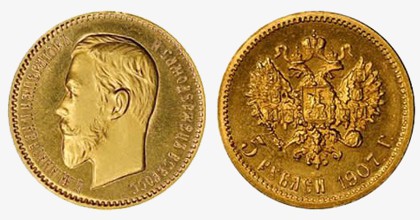
5 rubles in 1907
When laying the foundation of the church of St. Olga in the camp of the Life Guards of the Horse Regiment near St. Petersburg in August 1907, 100 gold coins worth 5 rubles were placed at the base of the temple in honor of the centenary of the regiment participating in the battle with Napoleon’s army near Friedland. The ceremony was attended by Nicholas II, Empress Alexandra Fedorovna and Grand Duchess Olga Nikolaevna, in whose honor the church was built. These coins differed from ordinary five-ruble coins only in the issue date, since in 1907 five-ruble gold coins were not issued for the sphere of circulation. The remaining 9 copies of coins from the special issue were presented to the participants of the ceremony. Periodically, they pop up at various auctions. So, in March 2011 at the auction of the auction house "Alexander" a coin in denomination of 5 rubles in 1907 was sold for 4.35 million rubles. Five years before, in October 2006, at the Coins and Medals auction, the same coin was sold “for only 2.7 million rubles.”
25 rubles in 1908 - 1.9 million rubles.
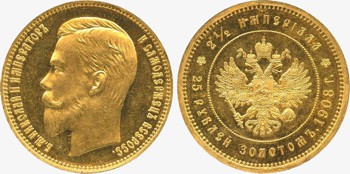
25 rubles in 1908
A coin in denomination of 25 rubles in 1908 is considered very rare. An interesting story is its appearance. At the beginning of the 20th century, a huge gold nugget weighing 5 kg was found in Siberia. By order of Nicholas II, coins were made from this nugget, which the last Russian emperor planned to give to his closest friends and relatives during the celebration of his birthday in 1908. Although this coin is considered very rare, over the past year and a half it has been put up for auction five times at Russian and foreign auctions. The last case of sale was recorded in April 2011 at the Empire auction. The coin is not in the best condition, having nicks and scratches in its field, was sold for 1.9 million rubles. In perfect condition, it could cost twice as much.
5 kopecks in 1916 - 1.6 million rubles.
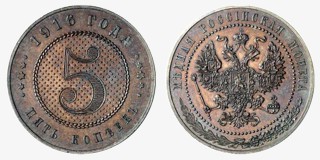
5 kopecks of 1916
During World War I, there was an acute shortage of silver and copper in Russia. It was decided to conduct a monetary reform in the country, as a result of which it was planned to issue copper coins two times lighter than those that were in circulation. However, the revolution prevented the implementation of these plans. But still, a number of trial copper coins of 1916 were issued. No one knows for sure how many of them were minted.
In 1927, the Leningrad Mint minted a number of such coins with genuine stamps for sale to collectors. However, they are still considered rare. In April 2011, trial 5 kopecks of 1916 were sold at the Coins and Medals auction for 1.6 million rubles. For comparison: in the fall of 2010, exactly the same nickel was sold at auction for 1.3 million rubles.
50 kopecks in 1929 - 10 million rubles.
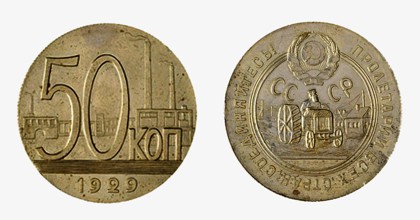
50 kopecks in 1929
Although the article is devoted to the most expensive coins of tsarist Russia, I can not help adding a description of one coin of the Soviet period, since it is painfully rare and expensive.
After completing the course on a new economic policy (NEP), the Soviet government decided to replace silver coins with copper-nickel. Silver in those years was planned to be used for industrialization. In 1931, new coins of 10, 15, and 20 kopecks were minted and put into circulation. Coins in denominations of 1 ruble and 50 kopecks were deemed unnecessary. However, by the time the Leningrad Mint had already minted a circulation of new fifty dollars, which was subsequently destroyed. However, several years ago, one copy of a coin in denomination of 50 kopecks of the 1929 model was discovered in a private collection. This is the only known sample released that year. In May 2011, at the Znak auction, the coin was sold to an anonymous buyer by telephone, who paid 10 million rubles for it. This is the record price paid for the Soviet coin.
10 most expensive coins of Tsarist Russia January 15th, 2014
This is the most expensive coin of Tsarist Russia. It is known that one copy of this coin was sold at auction of 1,782,500 pounds.
This coin was minted in gold during the reign of Empress Elizabeth Petrovna in 1755 at the mint of St. Petersburg.
The obverse of this coin depicts the Empress Elizabeth Petrovna herself.
On the back is a cross consisting of five cartouches. In the center is the coat of arms of the Russian Empire, and around the arms of Kazan, Moscow, Siberia and Astrakhan.
This is a very rare coin; today only two of its copies are known. One is in the Hermitage, and the second in a private collection.
2) 1 ruble of 1730, or as it is also called "Anna with the chain."
This is also a rare and expensive coin of Imperial Russia. It was minted in the first years of the reign of Empress Anna Ioannovna in 1730 from silver. And received in common people the name "Anna with a chain."
The obverse of the coin depicts a portrait of the empress herself. And the reverse of "Anne with a Chain" is decorated with the emblem of Imperial Russia - a two-headed eagle with three crowns, which is surrounded by a chain of the Order of St. Andrew the First-Called.
As I said earlier, this is a very rare coin, since only three copies of Anne with the Chain are known.
The cost of the coin varies in the region of $ 700,000, it was for this amount that one of the copies of the coin 1 ruble of 1730 was sold.
3) 12 rubles in 1836.
This is the only platinum coin in the world that has been released for circulation on the market.
And is a rare coin. It is known that coins in nominal value of 12 rubles in 1836 were minted in very small quantities, namely in a print run of 11 pieces. Although it is known that at the end of the 19th century, a certain number of “rubles” were issued by order of private collectors, they are already considered remodels. And their price is much inferior to the originals.
In the past, 2011, at one of the auctions, the original coin of 12 rubles in 1836 was sold for 4,650,000 rubles.
4) 5 rubles in 1907.
It is also a very valuable and rare coin. She has a very interesting story.
In August 1907, near St. Petersburg, the construction of the church of St. Olga in the camp of the Life Guards Horse Regiment. And for this event, the mint struck 100 gold coins in denominations of 5 rubles, which were laid in the foundation of the church.
From ordinary five-ruble coins, they differed only in the date of issue. In addition to the 100 coins that were laid in the foundation of the temple, more than five rubles were not issued, so this coin was never in circulation.
After the ceremony of laying the foundation of the temple, another 9 5 ruble coins of 1907 surfaced. As it turned out, they were minted along with those, but only in order to distribute them by the participant of the event.
It is known that in March 2011, a coin of 5 rubles in 1907 was sold for 4,350,000 rubles.
5) 1 ruble of 1825, or as it is more known, "Konstantinovsky ruble".
This is probably the most famous coin in Russia. And its origin is shrouded in a veil of mysteries, because the Emperor with the name Constantine in Russia has never been. Then in honor of whom it was minted?
But there are two versions. According to the first, this is a simple mistake of the mint workers, which of course is unlikely. But based on the second version, the "Konstantinovsky ruble" was minted with the expectation of the coronation of Tsarevich Konstantin Pavlovich. But he subsequently abdicated in favor of his brother Nicholas I. But the coin remained.
The obverse of the coin depicts a bald man with sideburns and a short upturned nose. In the circle of the coin there is an inscription: “B, M. Konstantin I IMP and SAMEROSS ALL” and the year 1825 is indicated.
The reverse depicts a double-headed eagle with regalia surrounded by a wreath of laurel leaves. Under the eagle is indicated the mint that minted this coin - St. Petersburg. In a circle the inscription: "Ruble. Pure silver 4 gold. 21 share."
The inscription is engraved on the edge (edge) of the coin: "ser 83 13 samples 4 gold 82 1425 shares."
The cost of this coin ranges around $ 100,000.
6) 1 kopeck of 1726.
It is also a rare and expensive copper coin. It has an unusual shape and weight. The penny is made in the form of a square and has a weight of 16.38 grams. And the size is 23x23 mm. It was minted in 1726 in the mint of the city of Yekaterinburg.
Only 10 copies of the coin that have survived to this day are known for certain. Its cost is great, despite the fact that it is made of copper. At one of the auctions, 1 kopeck of 1726 was sold for 2,000,000 rubles.
7) 25 rubles in 1908.
The coin is also very rare and expensive. A more interesting story is its origin.
A large gold nugget weighing 5 kilograms was found at the imperial mines in Siberia at the beginning of the 20th century. At that time, the reigning emperor, Nicholas II, wanted to make coins from gifts of gold for gifts to his relatives and friends at the celebration of his birthday. The nugget was only enough for 150 gold coins. Later, by order of Prince George Mikhailovich, a passionate collector, another 25 coins were minted.
What its cost is not exactly known. It is only known that the “25 rubles 1908” coin of poor quality (with scratches and nicks) at one of the auctions sold 1,900,000 rubles. And according to some experts, a coin of good quality may cost twice as much.
8) 5 kopecks in 1916.
This coin is the fruit of a failed monetary revolution. As you know, in those years the First World War was fought. In this connection there was a shortage of silver and copper for minting coins. Therefore, it was decided to issue money twice as easily. But the revolution that happened prevented the realization of the plan. But the trial batch was still minted. What circulation the trial batch had was not known.
And in 1927, a certain amount of coins for collectors were minted at the Leningrad Mint with a genuine stamp. But despite this, 5 kopecks of 1916 is considered rare. One copy of the five-copeck coin was sold at auction for 1,600,000 rubles.
9) 1 ruble of 1806.
Emperor Nicholas I, who ascended the throne, for some reason forbade the minting of coins with his profile. Although award medals with his portrait were issued.
In the mid-19th century, remodels of 1 ruble coin with its image in the amount of about 30 pieces were issued at the Mint of St. Petersburg, by private order.
The reverse of the coin depicts Nicholas I in the guards uniform, and the obverse is decorated with a two-headed eagle - the emblem of the imperial power.
One of the coins “1 ruble of 1806” was sold for 1,550,000 rubles. Although experts, numismatists claim that its current value is more than 2 million rubles.
10) 1 ruble of 1705 or the "Polish Thaler".
In 1704, by decree of Peter I, silver coins were introduced into circulation, reminiscent in appearance of the Polish thaler of the sample of 1630. The fact is that until 1730, when silver deposits were developed in Altai, a strong silver deficit was observed in the Russian Empire. In this connection, coins were minted from imported metal. Sometimes the “imported” coins were not even melted, but were immediately sent to the press.
Therefore, the coin 1 ruble of 1705 was minted from the Polish thaler, and even with an error in writing the date.
A coin with an error in writing the date is valued. One of the coins “1 ruble of 1705” was sold at auction for 1,500,000 rubles. A coin of the same denomination, but made of molten metal, was sold for just 400,000 rubles.
What does the modern generation know about the Russian Empire? These are Pushkin and Lermontov, the war with the French, prefabricated buildings, the abolition of serfdom. This theoretical knowledge - you can not touch it. However, another story has survived, which many still have as an inheritance from great-grandmothers and great-grandfathers - ancient coins with the proud symbol of Russia, the double-headed eagle. How much are such coins, many do not suspect. However, collectors and numismatists hunt them fiercely, and therefore the cost of some can reach really fabulous amounts. What coins of the Russian Empire are now considered the most expensive?
20 rubles in 1755. Gold coin that was issued after the monetary reform. For the first time a face value of 20 rubles was used. Then released only two copies of such twenty-ruble. One copy is currently an exhibit of the Hermitage, and another is bought for a private collection for one and a half million pounds. This is more than eighty-seven million rubles.
1 ruble of 1730. The empress Anna is depicted on it, and therefore, this coin was popularly nicknamed "Anna with a chain." The reverse of the coin is decorated with the emblem of the Russian Empire. This silver coin is estimated at almost twenty-five million rubles. Today, only three surviving copies of this rare coin are known.
1 ruble of 1825. One of the most famous coins of the times of the Russian Empire, called "Konstantinovsky ruble." Why it bears such a name is a mystery covered with centuries-old dust. In Russia, there was never an emperor named Constantine. Someone believes that its release is a mistake. Someone is sure that it was made, waiting for the coronation of Tsarevich Konstantin Pavlovich. One way or another, today this coin is worth one hundred thousand dollars - more than thirty-five million rubles.
12 rubles in 1836. Unique platinum coin. By the way, only the Russian Empire in the entire history of the world used platinum to make coins that went into circulation. Then issued only eleven such twelve-coin. To date, the coin is estimated at 4.65 million rubles, but its value is constantly growing.
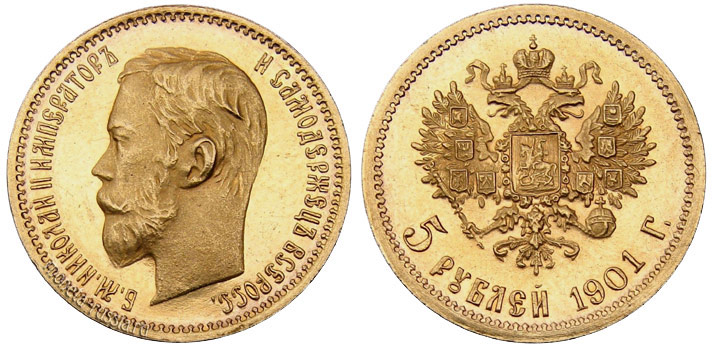
5 rubles of regular coinage, 1897-1911 4.3 gr. gold of 900 tests, the content of pure metal is 3.87 g.
5 rubles in 1907. At the beginning of the twentieth century, when the construction of hangars and other technological buildings still did not show signs of life, the main building event was always the construction of the temple. One hundred gold five-ruble coins laid the foundation of the church of St. Olga, built near St. Petersburg in 1907. They differ from the usual five-ruble coins by the date of issue. After the solemn mortgage, nine coins remained - they were presented to the participants of the ceremony. At the moment, the coin is estimated at 4.35 million rubles.

